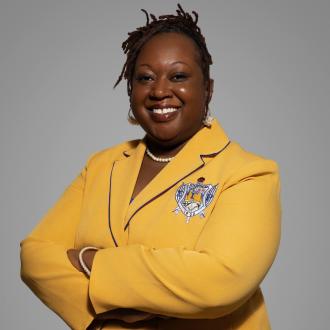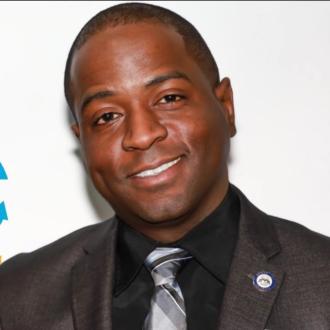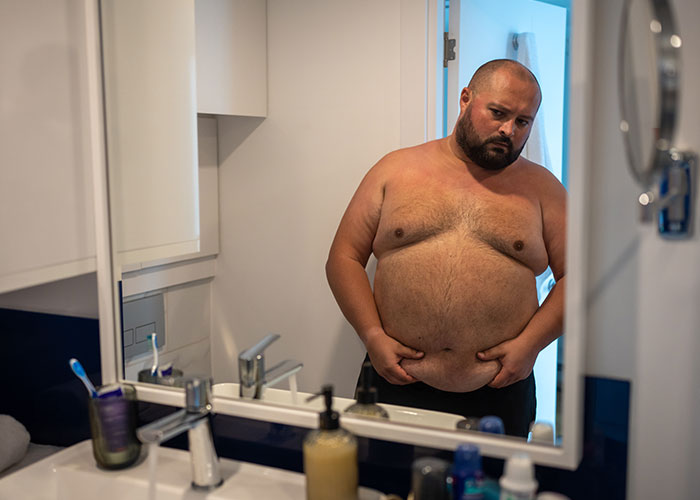Voices Of Vogtle: Four Oral Histories

As part of Grist and WABE’s yearlong collaboration to demystify the Georgia Public Service Commission, we hosted a Community Reporting Fellowship — a six-week training program in which fellows learned journalism skills and created a project about energy issues in their communities.
Fellow Cassandra Loftlin, who lives in Augusta, Georgia, produced this project, featuring oral history interviews with several people in the area who have been part of the story of Plant Vogtle.
Learn more about the fellowship program, and other fellows’ projects.
As you wind along State Route 23 in Waynesboro, Georgia, the landscape gradually shifts from rural countryside to an industrial campus. Rising above the trees, four massive hourglass-shaped towers stand forcefully against the light blue sky, steady plumes of steam billowing upward: Georgia Power’s Plant Vogtle, the largest nuclear power plant in the U.S.
Here in the Augusta area, stories of the plant weave together like a patchwork quilt: aspirations, obstacles, and tales tightly sewn into the fabric of the community. The history of Plant Vogtle is long and controversial, from its initial approval in the 1970s through years of construction, additions, major cost overruns, and a contractor bankruptcy, which all contributed to bill increases for Georgia Power customers. The plant, and its expansion (as of 2022, nuclear power makes up 23% of Georgia Power’s energy mix), has sparked debates over its environmental and human impacts and risks.
I’m a resident of Augusta, a stone’s throw from Plant Vogtle. As construction on the two new reactors wrapped up in 2024, I sought out a few people to capture some oral histories of the plant’s history, operations, and current controversies. In these four short stories, I talk to a politician, a former construction worker on Plant Vogtle, a local organizer, and a current technician for the plant about their experiences.
Lawrence “Larry” Russell
Retired Engineer, Plant Vogtle
When Larry Russell left his civil engineering career in the Army in 1974, he moved to South Augusta, where his parents had given him property adjacent to theirs. This relocation and his master’s degree in physics sparked an interest in the nuclear industry. He recalls the optimism surrounding Plant Vogtle. “It felt like a wave of hope,” he remembered. Russell joined the early efforts in Shell Bluff, Georgia, to build the plant. The rural area’s proximity to the Savannah River, which provides essential cooling water for the reactors, and low population density — mostly by Black residents — made land acquisition easier for developers. (Editor’s note: Shell Bluff residents live just miles from both Plant Vogtle and the Savannah River Site, where nuclear waste is stored, and have raised concerns for decades about contamination risks.)
Russell remembers his time there: “I went over to the Savannah River Site, known as the Savannah River Plant at the time, and landed a job with Georgia Power. They stationed us out at Shell Bluff. At first, there wasn’t much to do. I was hired as a civil engineer, and worked out of an old peanut warehouse facility, reading documents about the [proposed] plant and nuclear procedures…while they were clearing the land — just thick woods, filled with tall trees and dense underbrush. After a few weeks, we moved into trailers on the current site of the plant, which at the time had not yet been named.”
Construction on Plant Vogtle paused due to financing difficulties, leading to the cancellation of two of the four Vogtle reactors. Building resumed in 1976, and the site was named the Alvin W. Vogtle Electric Generating Plant in honor of Southern Company’s CEO. Around this time, Russell lived in Indonesia, where he worked on a power plant, but returned home to Augusta with his family in 1981 to take care of his mother. He transitioned to an industrial engineering role at Plant Vogtle during the construction of Unit 1, which was completed in 1987.
He felt confident in his work. “It took a long time to get everything in place before Unit 1 was finally completed. [After] I transitioned from construction to operations and continued my career at Georgia Power, focusing on Unit 2,” he said. “The role was key to ensuring the plant’s safe and efficient operation. I primarily wrote procedures, ensuring everything adhered to the strict guidelines set by the Nuclear Regulatory Commission. I spent years in training and also went to Pittsburgh for emergency procedures training at Westinghouse, which supplied much of the plant’s hardware.” (In 2017, Westinghouse, a subsidiary of Toshiba, went bankrupt primarily due to cost overruns from Vogtle construction.)
“Now with Units 3 and 4 in there, there’s a lot more going on,” Russell said. These reactors took over a decade each to complete, largely due to cost overruns and other construction delays.
During his tenure, the management of Plant Vogtle transitioned from Georgia Power to Southern Nuclear, where Russell continued his work for 11 more years until retiring. “I’ve seen a lot of changes over the years, but the commitment to safety and doing things the right way at Plant Vogtle has always stood out. Everything we did was carefully planned and executed to ensure the utmost safety for everyone involved.”
Dr. Onnie Poe
Founder, Filling the GAPS

Onnie Poe was at a roundtable discussion at a National Coalition on Black Civic Participation event in Macon in June when she first heard about the Georgia Public Service Commission, or PSC. “When the ladies came up and were talking about energy and the rates of power bills, one of the presenters asked, ‘How many of you know about the Public Service Commission?’ I was like, I [have] never heard about the Public Service Commission.”
After years of advocacy work — especially through her organization, Filling in the GAPS, which provides education, advocacy, and support for individuals and families affected by disabilities and mental health challenges — she was surprised by this blind spot in her knowledge. “I’ve always tried to stay informed, but this was new to me,” she said. Poe said the moment marked a turning point for her — it sparked a deeper curiosity about how the PSC’s policies and decisions directly impact her community.
The PSC is the small but powerful state-elected board that made these decisions to raise rates; the five-member commission oversees Georgia Power. The uptick in energy costs because of these decisions — as well as other issues related to major decisions about renewable energy, electricity costs, and rate hikes the PSC has approved — has sparked discussions among the public. While the PSC often goes unnoticed by many voters, some local community activists are pushing for more transparency.
Poe started with trying to better understand Plant Vogtle in her community and how it is connected to the PSC. She found herself frustrated with residents’ high bills and the lack of transparency about them — especially charges that were related to the plant’s construction.
Originally estimated to cost $14 billion, the Plant Vogtle expansion was “plagued by repeated delays and ultimately cost an estimated total of more than $31 billion,” as Grist and WABE reported earlier this year. In the spring of 2024, the PSC approved a rate hike proposed by Georgia Power, and customers saw bill increases of about $9 as the fourth nuclear reactor at Plant Vogtle came online. It was the latest of several rate hikes for the project: Georgians have seen their bills go up multiple times to pay for the new reactors and for shareholders of Georgia Power, who had to absorb some of the costs.
“I didn’t connect the two,” Poe said. “Why don’t I know that they’re connected? And what can I do about it?”
As the social action chair for the Delta Alpha Sigma Chapter of Sigma Gamma Rho Sorority, Poe said she is now committed to keeping her sorority sisters informed about critical issues like this. She starts with asking people who they get their information from — who they trust. She plans to host community roundtables in Augusta starting in mid-September to foster dialogue and raise awareness about the PSC and its influence on energy costs.
Carion Crews
Senior Decontamination Technician, Radiation Protection Technician, Day & Zimmermann

Carion Crews started in the nuclear industry in 2008 as a temporary worker. “I honestly just needed money at first,” she said. She explored other career options and attended college, but she was drawn back to the field in 2015, and was placed with Day & Zimmermann through a labor union apprenticeship program. The construction and engineering company had contracted with Plant Vogtle owners to do maintenance. “[It] was a very competitive process. I really enjoy my work, so I’ve been in the industry ever since.”
In her dual roles as a senior decontamination technician and radiation protection technician, she is responsible for managing radiation levels within the plant. While Crews works at various nuclear plants across the country, she spends most of her time at Plant Vogtle as a subcontractor. She oversees the installation of protective barriers, does cleanup of any contamination, and ensures that all safety procedures are followed. She said she’s “found fulfillment in the meticulous and critical nature” of her work.
Her days vary depending on which area of the plant she’s in: “It could be something like a boric acid spill or another type of contamination,” she said (boric acid is used as a coolant in reactors to control the nuclear fission process). “The first step is getting dressed out in our protective clothing [PPE]. ‘You look like a minion!”
Once suited up, Crews and her team use smears, a tool that’s used to detect radiation levels, to check the area. A moistened filter paper or cloth is used to wipe a surface before it’s measured by a machine. “My job is all about safety — making sure radiation levels are controlled and that every procedure is followed to the letter. It’s crucial work because it protects both the workers and the surrounding community. Every barrier we put up and every piece of equipment we clean is part of ensuring the plant operates safely and effectively.”
Here’s how a nuclear reactor works: Uranium, a naturally occurring radioactive element, is enriched and put inside fuel rods in the reactor, and immersed in water. This keeps them cool during the process of nuclear fission, which creates steam that’s used to produce electricity. The water surrounding this core of the reactor often glows blue because the atoms are moving so quickly they’re producing light. This process is called “Cherenkov radiation.” When the reactor gets really hot, radiation starts “popping off,” Crews said, so that’s when the levels can spike. “But even then, we’re still protected, and so is the environment,” she said. “That’s why they bring us in during those times — to manage the situation. On a daily basis, though, we’re not usually working directly around the reactor; that only happens during specific times like refueling.”
When contamination or radiation is detected, the next steps depend on the severity. Crews said that typically, a safe level is below 2,000 disintegrations per minute (DPM), or at less than two millirems per hour. Millirems (mrem) measure the amount of radiation absorbed by the human body. The average American receives about 620 millirems each year from background radiation and other things like X-ray and food, according to the NRC. The occupational exposure limit for radiation workers in the U.S. is 5,000 millirems per year, set by the NRC.
Occupational exposure at nuclear plants has decreased through the years globally, and research has shown that the exposure among nuclear plant workers is relatively low. Given the nature of her work, friends and family often express concerns about her health. “My family used to joke that I’d eventually come home glowing because of the radiation. But that’s just not how it works.”
“Every day is different,” Crews said, “but knowing that what we do keeps people safe is incredibly rewarding.”
Daniel Jackson
Politician

Daniel Jackson’s connection to Augusta is deeply rooted because of Fort Eisenhower — the home of the U.S. Army Signal Corps, a branch of the Army responsible for military communications — which brought his family to the area from Alabama. “I grew up here. South Augusta is home,” he said.
Jackson is a politician and military veteran who ran for Georgia’s 12th Congressional District in 2024 (he lost in the Democratic primaries). His perspective on Plant Vogtle and nuclear power is deeply influenced by his military experience, he said. “I believe in the diversity of power sources — we can’t just have all solar or all hydro; we need to have that diversity. If other power sources face challenges, having nuclear power in the region provides a critical backup.”
But, he said, he didn’t really “emphasize Plant Vogtle during my campaign because I know there are pros and cons — people on both sides.” Nuclear power is particularly contentious in Georgia’s 12th Congressional District, which encompasses a large portion of eastern Georgia — including Augusta, Waynesboro, and parts of Savannah, where Plant Vogtle and Savannah River Site provide hundreds of jobs and are an integral part of the area’s economy, but communities surrounding the sites have been fighting the plants for decades over environmental and health risks from radiation and other contamination. Georgia Power rate hikes due to construction on Plant Vogtle have also drawn criticism from both Republicans and Democrats in the state.
Jackson said he thinks the costs of the plant — which are offloaded onto Georgia Power customers as the company had to pay for the plant’s expansion and ballooning construction budget — are worth it. “Even though ratepayers have to cover overages in the short term, the long-term benefits of nuclear power are significant.”
Nuclear power critics cite concerns about safety risks, such as potential accidents, nuclear waste management, environmental impacts, and the high costs associated with nuclear energy. And those are warranted: there is a major risk for radiation exposure if an accident happens. How to store radioactive waste is an ongoing issue in Georgia: radioactive nuclear waste and other contaminated materials are stored just 25 miles from the plant at Savannah River Site, a federal Superfund site across the Savannah River from Vogtle in South Carolina.
There are many safeguards in place for Plant Vogtle: Georgia Power has an emergency plan that it uses in coordination with local officials; the Nuclear Regulatory Commission also has emergency information for the plant. But events still happen and the surrounding community and workers are used to alarm bells ringing: For instance, in August, a fire at the plant spurred alarm but it did not affect the cooling system. In July, a technical glitch caused Unit 3 to go offline for a short time. Jackson said he understands these concerns. “Transparency is key,” he added. “It’s on local government to make sure they’re conveying the message about Plant Vogtle, what it’s doing for us, and addressing any concerns about its impact on the community.”
He cited his own concerns about a lack of education and ineffective communication regarding energy projects, risks, and emergency protocols. “The biggest problem I see is that we often put out information without ensuring it reaches everyone effectively,” he said. “It costs money and time, but it’s necessary.”
A way to do that is using all types of media, he said — from social media to radio to in-person conversations. “Education is key. The [emergency] plan only works if everyone knows about it,” Jackson said. “You have to prioritize your community first and foremost. We all need to come together on this because it’s too important an issue to leave to disinformation campaigns. We must be transparent and convey our message clearly.”
This story was originally published by Grist with the headline Voices of Vogtle: Four oral histories on Aug 29, 2024.


